
The Battle of Leipzig, also known as the Battle of the Nations, was fought from 16 to 19 October 1813 at Leipzig, Saxony. The Coalition armies of Austria, Prussia, Sweden, and Russia, led by Tsar Alexander I and Karl von Schwarzenberg, decisively defeated the Grande Armée of French Emperor Napoleon Bonaparte. Napoleon's army also contained Polish and Italian troops, as well as Germans from the Confederation of the Rhine. The battle was the culmination of the German Campaign of 1813 and involved 560,000 soldiers, 2,200 artillery pieces, the expenditure of 400,000 rounds of artillery ammunition, and 133,000 casualties, making it the largest battle of the Napoleonic Wars, and the largest battle in Europe prior to World War I.
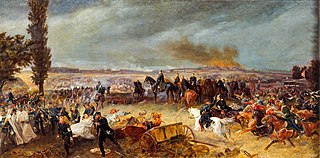
The Battle of Königgrätz was the decisive battle of the Austro-Prussian War in which the Kingdom of Prussia defeated the Austrian Empire. It took place on 3 July 1866, near the Bohemian city of Hradec Králové and village of Sadová, now in the Czech Republic.

The Silesian Wars were three wars fought in the mid-18th century between Prussia and Habsburg Austria for control of the Central European region of Silesia. The First (1740–1742) and Second (1744–1745) Silesian Wars formed parts of the wider War of the Austrian Succession, in which Prussia was a member of a coalition seeking territorial gain at Austria's expense. The Third Silesian War (1756–1763) was a theatre of the global Seven Years' War, in which Austria in turn led a coalition of powers aiming to seize Prussian territory.

The Battle of Leuthen was fought on 5 December 1757 and involved Frederick the Great's Prussian Army using maneuver warfare and terrain to rout a larger Austrian force completely, which was commanded by Prince Charles of Lorraine and Count Leopold Joseph von Daun. The victory ensured Prussian control of Silesia during the Third Silesian War, which was part of the Seven Years' War.

The Battle of Maxen was a battle at Maxen, in the Electorate of Saxony during the Third Silesian War. It resulted in surrender of a Prussian corps.
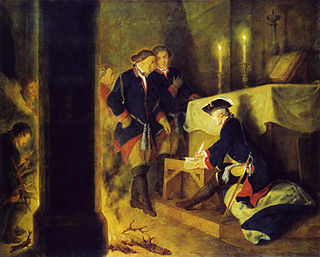
In the Battle of Torgau on 3 November 1760, King Frederick the Great's Prussian army fought an Austrian army under the command of Field Marshal Leopold Josef Graf Daun. The Prussians won a costly victory in one of the bloodiest battles of the Third Silesian War.

The Battle of Chotusitz, or Chotusice, sometimes called the Battle of Čáslav, took place on 17 May 1742, in Bohemia, now the Czech Republic; it was part of the 1740 to 1742 First Silesian War, itself a subsidiary of the wider War of the Austrian Succession.

Hans Joachim von Zieten, sometimes spelled Johann Joachim von Ziethen,, also known as Zieten aus dem Busch, was a cavalry general in the Prussian Army. He served in four wars and was instrumental in several victories during the reign of Frederick the Great, most particularly at Hohenfriedberg and Torgau. He is also well known for a raid into the Habsburg territories during the Second Silesian War, known as Zieten's Ride. After engaging in a reputed 74 duels, and fighting in four wars, he died in his bed at the age of 86.

The Second Silesian War was a war between Prussia and Austria that lasted from 1744 to 1745 and confirmed Prussia's control of the region of Silesia. The war was fought mainly in Silesia, Bohemia, and Upper Saxony and formed one theatre of the wider War of the Austrian Succession. It was the second of three Silesian Wars fought between Frederick the Great's Prussia and Maria Theresa's Austria in the mid-18th century, all three of which ended in Prussian control of Silesia.

Hans Karl von Winterfeldt, a Prussian general, served in the War of the Polish Succession, the War of Austrian Succession, Frederick the Great's Silesian wars and the Seven Years' War. One of Frederick's trusted confidantes and advisors, he attracted enmity from other courtiers. Frederick entrusted him with considerable autonomy on the general staff, and Winterfeldt developed the first "modern" program of military intelligence gathering. He negotiated the Convention of Westminster and, for his efforts on Frederick's behalf, received the Order of the Black Eagle and the Order Pour le Mérite. He died from wounds received at Battle of Moys. His name is included on the Equestrian statue of Frederick the Great.
The Cuirassier Regiment "Queen" (Pomeranian) No. 2 was a Prussian cavalry regiment. Formed in 1717 as Dragoner-Regiment Nr.5 Bayreuth Dragoner it was originally a dragoon regiment and was part of the Prussian order of battle until 1918. The Bayreuth Dragoons achieved fame for their role in winning the Battle of Hohenfriedberg in 1745. In 1819 it was transformed into a cuirassier regiment.

The Battle of Soor was a battle between Frederick the Great's Prussian army and an Austro-Saxon army led by Prince Charles Alexander of Lorraine during the Second Silesian War. The battle occurred in the vicinity of Soor, also known as Hajnice, in the modern day Czech Republic. The battle started with a failed Austrian surprise attack on the outnumbered Prussians. Despite initial setbacks the Prussian army managed to defeat the Austrians, due to an unexpected attack from a reserve regiment that refused to follow Frederick's orders.
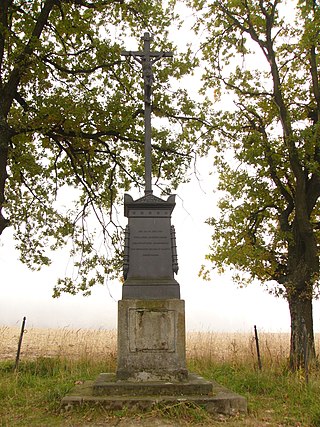
The Battle of Domstadtl was a battle between the Habsburg monarchy and the Kingdom of Prussia in the Moravian village of Domašov nad Bystřicí during the Third Silesian War on 30 June 1758, preceded by a minor clash at Guntramovice (Gundersdorf) on 28 June. Austrians under the command of Major General Ernst Gideon von Laudon and Major General Joseph von Siskovits attacked and destroyed a supply convoy bound for the Prussian army besieging Olomouc (Olmütz). The Austrian victory saved the city and the Prussian King Frederick the Great was forced to leave Moravia.

The Royal Prussian Army served as the army of the Kingdom of Prussia. It became vital to the development of Prussia as a European power.
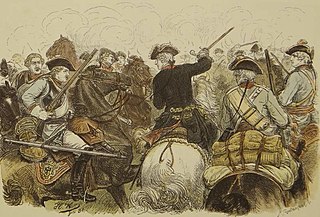
The First Silesian War was a war between Prussia and Austria that lasted from 1740 to 1742 and resulted in Prussia's seizing most of the region of Silesia from Austria. The war was fought mainly in Silesia, Moravia and Bohemia and formed one theatre of the wider War of the Austrian Succession. It was the first of three Silesian Wars fought between Frederick the Great's Prussia and Maria Theresa's Austria in the mid-18th century, all three of which ended in Prussian control of Silesia.

The Battle of Hennersdorf, sometimes referred to as Catholic-Hennersdorf, was a minor encounter that took place on November 23, 1745 in Katholisch-Hennersdorf in Silesia during the Second Silesian War. The Prussians under Frederick II defeated the Austrians under Prince Charles Alexander of Lorraine. The Prussians surprised the Austrians and Saxons in their cantonments in Lusatia with the most success at Hennersdorf. There a force of two regiments of hussars and two regiments of cuirassiers under Zieten attacked a small force of two battalions of Saxon infantry and three regiments of Saxon cavalry. The Saxons, after making a desperate stand, were overwhelmed by the arrival of additional Prussian cavalry, infantry and artillery.
"Der Hohenfriedberger", also called "Hohenfriedberger Marsch" or "Der Hohenfriedberger Marsch", is one of the most classic and well known German military marches. It takes its name from the victory of the Prussians over the allied Austrians and Saxons on 4 June 1745 during the Second Silesian War at the Battle of Hohenfriedberg, near Striegau.

The Third Silesian War was a war between Prussia and Austria that lasted from 1756 to 1763 and confirmed Prussia's control of the region of Silesia. The war was fought mainly in Silesia, Bohemia and Upper Saxony and formed one theatre of the Seven Years' War. It was the last of three Silesian Wars fought between Frederick the Great's Prussia and Maria Theresa's Austria in the mid-18th century, all three of which ended in Prussian control of Silesia.
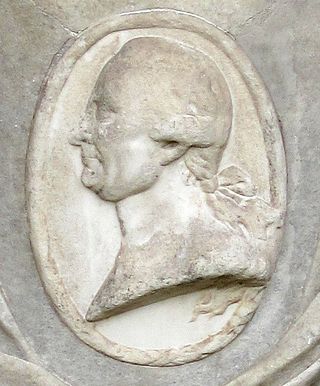
Hans Sigismund von Lestwitz was a Prussian major general of the infantry and was especially honored by Frederick II for his action in the Battle of Torgau. His decisive leadership at Torgau, in which he snatched victory from defeat, was credited at the time and subsequently with saving the Prussian state. Frederick acknowledged his action with the post-war gift of vast estates near Kunersdorf.

Johann Paul von Werner was chief of the Prussian Hussar Regiment No. 6 ; he also received the Prussian Order Pour le Mérite. Initially in Austrian service, he fought against Spain, France, the Ottoman Empire and against Prussia. One of Frederick the Great's trusted diplomats, Hans Karl von Winterfeldt, recruited him into Prussian service in 1750; subsequently, he fought for Prussia against the Austrians in the Seven Years' War and the War of Bavarian Succession. He was wounded once, and taken prisoner several times. The Prussian playwright Gotthold Lessing modeled the character of the sergeant in his Minna von Barnhelm on Werner.




















